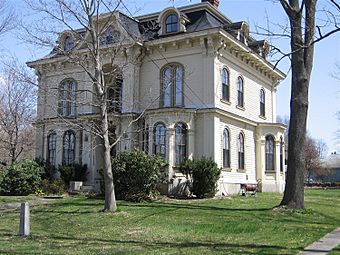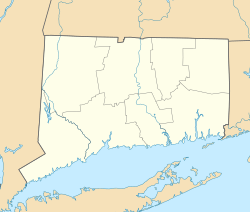Plainfield Street Historic District facts for kids
Quick facts for kids |
|
|
Plainfield Street Historic District
|
|

A Second Empire house on Norwich Road
|
|
| Location | Roughly, Norwich Rd. from Railroad Ave. to Academy Hill Rd., Plainfield, Connecticut |
|---|---|
| Area | 30 acres (12 ha) |
| Architect | Town, Ithiel |
| Architectural style | Greek Revival, Colonial, Federal |
| NRHP reference No. | 91000350 |
| Added to NRHP | April 11, 1991 |
The Plainfield Street Historic District is a special area in Plainfield, Connecticut. It's like a time capsule showing how the town center used to look. This historic district is found along Route 12, between Railroad Avenue and Route 14A.
It has been the heart of Plainfield for a very long time, since the early 1700s. You can see buildings from over 200 years of history here! This important district was added to the National Register of Historic Places in 1991.
Exploring Plainfield's Historic Center
The town of Plainfield was first settled by English colonists in the late 1600s. It officially became a town in 1699. The main meeting house, where people gathered, was built on a ridge east of the Quinebaug River. Today, the First Congregational Church of Plainfield stands in that same spot. It was built in 1816 and designed by a famous architect named Ithiel Town.
A Crossroads Community
The road along the ridge, now known as Route 12, became a very important north-south route in eastern Connecticut. Another key road, connecting Hartford with Providence, Rhode Island, crossed it. This is now Route 14A and Cemetery Road.
Plainfield's town center grew into a busy crossroads community until the early 1800s. Later, its importance changed as new textile mill villages grew much faster.
What You'll See in the District
Today, the Plainfield Street Historic District is mostly a residential area. This means it has many homes. There are also some shops and businesses at its northern end.
The district includes 30 main buildings and 24 smaller buildings, like barns or sheds. Most of these buildings were built between the late 1700s and early 1800s. The homes are usually one or two stories tall and made of wood.
They show off many different architectural styles that were popular from about 1790 to 1880. You'll see only a few buildings from the 1900s. Besides the church, another important building is the Union Hall, built around 1800 in the Italianate style. The district's name comes from the original name of what is now Norwich Road.



